初中动词基本用法大全
- 格式:doc
- 大小:341.50 KB
- 文档页数:13

初中英语使役动词及其用法大全(总10页)--本页仅作为文档封面,使用时请直接删除即可----内页可以根据需求调整合适字体及大小--初中英语使役动词及其用法大全使役动词have, let, make (常用于复合结构)1. have的用法1)have +宾语+do(省略to的不定式):表示主语“要”“使”“让”宾语干某事,宾语和宾补之间是一种主动关系。
The rich lady had the singer eat with her servants.这位富有的女士让这位歌手和她的仆人一起吃饭。
I will have him come and help you.我会让他来帮助你的。
2)have+宾语+现在分词:表示让某人或物连续进行某动作或处于某状态中,宾语和宾补是一种主动关系。
The two cheats had the lights burning all night long.这两个骗子让灯整晚亮着。
He had us waiting for him three hours yesterday.昨天他让我们一直等了他三个小时。
I have them all talking to each other in English.我鼓励他们用英语交谈。
3)have +宾语+过去分词:表示主语的主观意志,即主语让别人为自己完成某事,宾语和宾补是动宾关系,还可以表示主语遭受到来利或不测的事。
Tom said he had had his TV set repaired.汤姆修了他的电视机。
(别人修的)Tom had his wallet stolen on the bus yesterday.昨天汤姆使他的钱包被偷了。
(别人偷的)4)have+宾语+形容词/副词/介词短语作宾补Please have your tickets ready.请准备好你的票。
The Emperor had nothing on.这位皇帝什么都没在做。
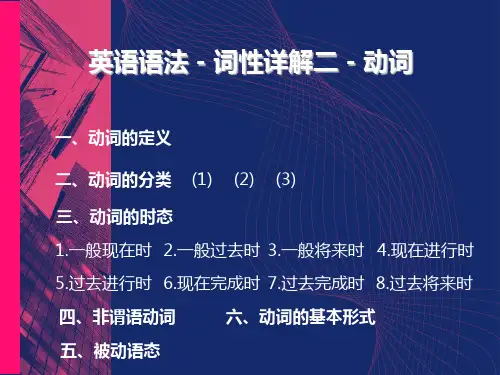
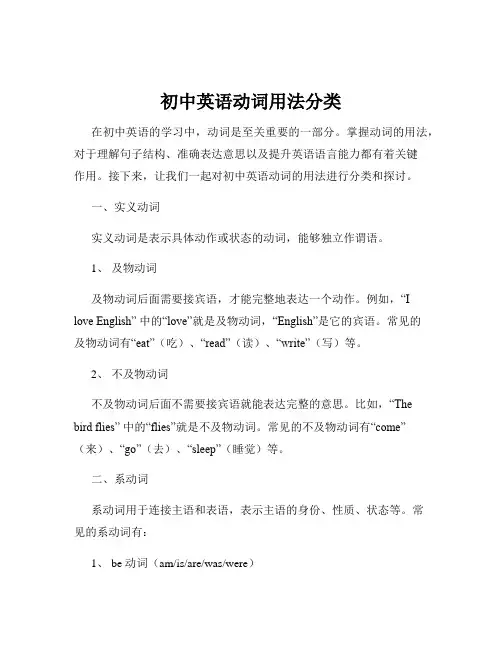
初中英语动词用法分类在初中英语的学习中,动词是至关重要的一部分。
掌握动词的用法,对于理解句子结构、准确表达意思以及提升英语语言能力都有着关键作用。
接下来,让我们一起对初中英语动词的用法进行分类和探讨。
一、实义动词实义动词是表示具体动作或状态的动词,能够独立作谓语。
1、及物动词及物动词后面需要接宾语,才能完整地表达一个动作。
例如,“I love English” 中的“love”就是及物动词,“English”是它的宾语。
常见的及物动词有“eat”(吃)、“read”(读)、“write”(写)等。
2、不及物动词不及物动词后面不需要接宾语就能表达完整的意思。
比如,“The bird flies” 中的“flies”就是不及物动词。
常见的不及物动词有“come”(来)、“go”(去)、“sleep”(睡觉)等。
二、系动词系动词用于连接主语和表语,表示主语的身份、性质、状态等。
常见的系动词有:1、 be 动词(am/is/are/was/were)这是最常见的系动词,例如,“I am a student”2、感官动词如 look(看起来)、sound(听起来)、smell(闻起来)、taste (尝起来)、feel(感觉起来)。
例如,“The flower smells sweet”3、表示变化的动词如 become(变得)、get(变得)、grow(生长,变得)、turn(变得)等。
比如,“It gets colder and colder”三、助动词助动词主要用于构成各种时态、语态、语气等。
常见的助动词有:1、 do/does/did用于一般现在时和一般过去时的否定句和疑问句中。
例如,“Do you like music?” “He doesn't like sports” “Did she go to the party?”2、 have/has/had用于构成现在完成时和过去完成时。
如,“I have finished my homework” “They had left before I arrived”3、 be 动词(am/is/are/was/were)用于进行时态和被动语态。
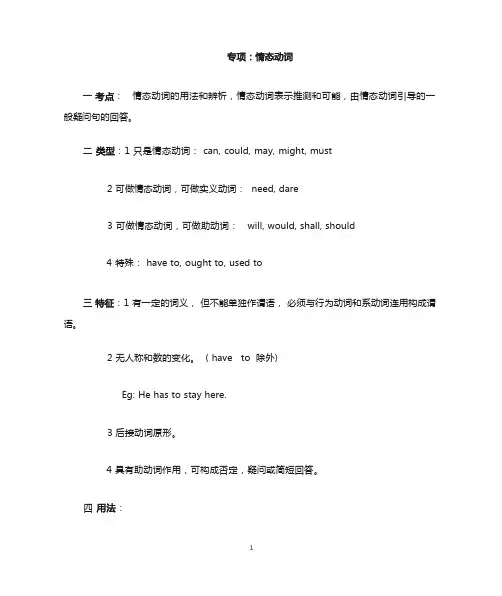
一情态动词的用法和辨析,情态动词表示推测和可能,由情态动词引导的一般疑问句的回答。
二 1 只是情态动词: can, could, may, might, must2 可做情态动词,可做实义动词: need, dare3 可做情态动词,可做助动词: will, would, shall, should4 特殊: have to, ought to, used to三 1 有一定的词义,但不能单独作谓语,必须与行为动词和系动词连用构成谓语。
2 无人称和数的变化。
( have to 除外)Eg: He has to stay here.3 后接动词原形。
4 具有助动词作用,可构成否定,疑问或简短回答。
四① 表示能力,“能,会”。
Eg : Can you play basketball?② 表示怀疑,猜测,常用于否定句或疑问句。
Eg :Li hua can’t be in the classroom.③ 表示请求,允许,多用于口语,译“可以”= may.Eg: youcangonow.④can 开头的疑问句,肯定句,否定句用 can 或 can’t.①can 的过去式,表示过去的能力。
Eg :I could swim when I was seven years old.②could 开头的疑问句,肯定和否定回答用 could, couldn’ t 如果 could 表示现在的委婉,用 can 回答。
Eg: Could I have a drink? Yes, you can.① 表示推测,“可能,也许”,用于肯定句。
Eg: He may come tomorrow.② 表示请求,“许可,可以”。
Eg: May I borrow your book?注:表示请求,许可时,主语为第一人称的一般疑问句,否定回答用 mustn’t“不可以,禁止,不许”,不用may not“可能不”。
③表示祝愿。
Eg :May you success.①表示“可以”,用于过去时中。

初中英语常用的动词用法初中英语常用动词用法:1. allow sb. to do sth. 允许某人去做某事My father allowed me to go out for a walk after finishing my homework.2. asked sb. (not) to do sth. 叫某人做事某事(叫某人不要去做某事)My father asked me to study hard.He asked me not to swim alone.be asked to do sth. 被叫去做某事/被邀请去做某事I was asked to have a dinner with them yesterday.3. be afraid to do sth. 害怕做某事She is afraid to ask me questions.4. be afraid of doing sth. 害怕做某事I am afraid of going out at night.5. be afraid of sth. 害怕某物He is afraid of snakes.6. be amazed to do sth. 对做某事感到惊讶He was amazed to meet the girl there.be amazed at sth. 对某事感到惊讶they were amazed at the news7. be busy doing/with sth. 忙于做某事 (常考)e.g: I was busy washing my car at that time. 那时候我正忙于清洗我的车子。
I am busy with my work.8. be ing/going/leaving/flying/moving/dying(某些位移动词用进行时态时表将来)the bus is ing/the dog is dying.9. be excited to do sth. 对做……感到兴奋Jacky was excited to travel there by plane.be excited at sth.Lily was excited at his words.be excited about doing sth.he was excited about passing the exam without going overing books.10. be frightened to do sth. 害怕去做某事Sam is frightened to ride a horse.11. be glad/happy to do sth. 高兴去做某事she is happy to clean the blackboard with me.be pleased to do sth. 高兴做某事she was pleased to help the old man yesterdaybe pleased with sth. 对某事感到高兴/满意the teacher was pleased with my answer.12. be interested in sth./doing sth. 对某事感兴趣/对做某事感兴趣she is interested in swimming in the river.My brother is interested in Chinese.13. be/get ready for/to do sth.Be ready for sth. 为某事做好了准备We are ready for the exam.Be ready to do sth. 为做某事做好了准备We are ready to have a birthday party for her.get ready for sth.为某事在做准备We are getting ready for the exam.13. be sorry to do sth. 对做某事感到抱歉14. be surprised to do sth. 对做某事感到惊奇be surprised at sth. 对某事感到惊奇15. be worth doing sth. 值得做某事 (worth 后接动词-ing 形式,常考)16. begin to do sth.begin/start to do/doing sth.17. can/be able to afford (to buy) sth. 有能力购买(供)……18. can/may/must do sth. could/would/should/might do sth.19. can't wait to do sth. 迫不急待地去做某事20. decide to do sth. 决定去做某事make up one's mind to do sth. 下决心去做某事 (常考)make a decision to do sth. 对做某事作出决定21. deserve to do sth. 值得/应该做……22. encourage sb. to do sth.鼓励某人去做某事23. enjoy doing sth. 乐意去做某事24. expect (sb.) to do sth. 期望去做某事25. fail to do sth. 做某事失败succeed doing sth. 成功做了某事26. finish doing sth. 做完某事(后接动词-ing形式) (常考)27. follow sb to do sth. 跟随某人去做某事28. get sb. to do sth.make sb. do sth.let sb. do sth.29. get/have a chance to do sth.得到一个做某事的机会30. give/pass/show/lend/sell sb. sth./ sth. tosb.buy/get/bring sb. sth. / sth. for sb.31. go on to do sth. 继续做事(常考)go on doing sth. 继续做事(常考)32. hate to do/doing sth. 讨厌/不喜欢做某事33. have fun doing sth.34. have problems doing sth.做某事遇到困难35. have sb. do sth.have sth. donehave sth. to do 有事要做36. hear sb. do sth. 听到某人做某事(后接动词原形,常考)hear sb. doing sth. 听到某人正在做某事(常见)37. help to do sth. 帮忙做某事help sb. (to) do sth.帮助某人做某事38. hope/wish to do sth. 希望做某事wish sb. to do sth. 希望某人做某事39. I t seems that 这像是……(后接从句)seem to dosth.seem +adj.40. It's + adj.+(for sb.) to do sth.It's + adj. +(of sb.) to do sthe.g: It's glad for him to hear the news.41. It takes sb. some time/money to do sth. 花费某人多长时间做某事(常考)42. pay …for…costspend…on…..it take …to do sth.43. It's best for sb to do sth.. 对某人来说做某事是最好的had better do sth. 最好做某事 (注意had没有时态和人称的变化,better后接动词原形)44. It's time for sb. to do sth. 是某人做某事的时候了45. keep (on)doing sth. 坚持做某事(常考)keep sb. doing sth. 让某人做某事(常考)keep sb. from doing sth. 阻止某人做某事(常考)keep sb./ sth. +adj.keep the book for 2 days 借这本书两天(不要用borrow或lend)46. learn to do sth. 学做某事learn sth. from sb. 向某人学习47. like to do/doing sth. 喜欢做某事like sb. to do sth. 喜欢某人做某事48. need to do sth.need doing sth./to be doneneedsth .needn't do sth.49. prefer to do sth. rather than do sth. 宁愿……而不愿……(常考)prefer doing sth. to doing sth. 喜欢做……胜过做……e.g: I prefer reading books to going shopping. 比起购物来,我更爱读书。

初中常见的动词的用法在初中英语学习中,动词的用法至关重要。
动词不仅在句子中充当核心成分,其形式和用法的变化也十分丰富。
掌握常见动词的用法,对于准确表达意思、提高语言运用能力有着关键作用。
一、be 动词be 动词是最基础也是最常用的动词之一,包括 am、is、are 三种形式。
am 用于第一人称 I 之后,is 用于第三人称单数(he、she、it)之后,are 用于第二人称 you 以及复数主语之后。
例如:I am a student(我是一名学生。
)She is very beautiful(她很漂亮。
)We are good friends(我们是好朋友。
)be 动词还可以与现在分词构成进行时态,表示正在进行的动作。
例如:I am reading a book(我正在读书。
)同时,be 动词与过去分词构成被动语态,强调动作的承受者。
例如:The book is written by him(这本书是他写的。
)二、实义动词实义动词是表示具体动作或状态的动词,如run(跑)、eat(吃)、sleep(睡觉)等。
1、及物动词与不及物动词及物动词后面必须接宾语,才能完整表达意思。
例如:I eat an apple(我吃一个苹果。
)“eat”是及物动词,“apple”是宾语。
不及物动词后面不需要接宾语就能表达完整的意思。
例如:Heruns fast(他跑得很快。
)“run”是不及物动词。
2、动词的时态一般现在时:表示经常发生的动作或存在的状态。
主语是第三人称单数时,动词要加“s”或“es”。
例如:He studies hard(他学习努力。
)一般过去时:表示过去发生的动作或存在的状态。
动词通常变为过去式,规则动词加“ed”,不规则动词有特殊的变化形式。
例如:I played basketball yesterday(我昨天打篮球了。
)现在进行时:表示正在进行的动作,由“be 动词+现在分词”构成。
例如:They are playing football now(他们现在正在踢足球。
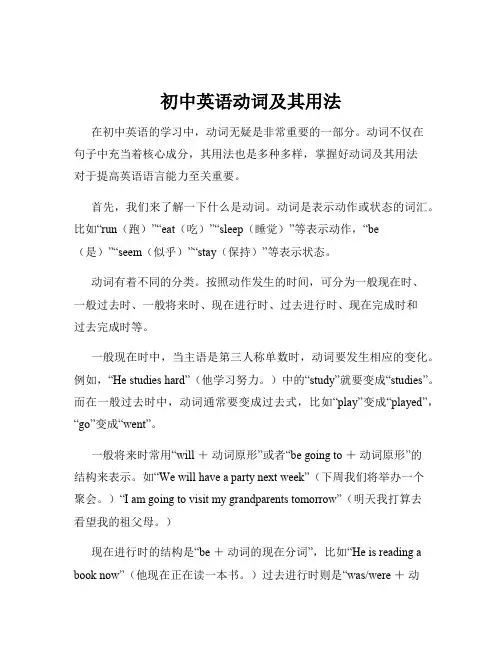
初中英语动词及其用法在初中英语的学习中,动词无疑是非常重要的一部分。
动词不仅在句子中充当着核心成分,其用法也是多种多样,掌握好动词及其用法对于提高英语语言能力至关重要。
首先,我们来了解一下什么是动词。
动词是表示动作或状态的词汇。
比如“run(跑)”“eat(吃)”“sleep(睡觉)”等表示动作,“be(是)”“seem(似乎)”“stay(保持)”等表示状态。
动词有着不同的分类。
按照动作发生的时间,可分为一般现在时、一般过去时、一般将来时、现在进行时、过去进行时、现在完成时和过去完成时等。
一般现在时中,当主语是第三人称单数时,动词要发生相应的变化。
例如,“He studies hard”(他学习努力。
)中的“study”就要变成“studies”。
而在一般过去时中,动词通常要变成过去式,比如“play”变成“played”,“go”变成“went”。
一般将来时常用“will +动词原形”或者“be going to +动词原形”的结构来表示。
如“We will have a party next week”(下周我们将举办一个聚会。
)“I am going to visit my grandparents tomorrow”(明天我打算去看望我的祖父母。
)现在进行时的结构是“be +动词的现在分词”,比如“He is reading a book now”(他现在正在读一本书。
)过去进行时则是“was/were +动词的现在分词”,“They were playing football at that time”(那时他们正在踢足球。
)现在完成时的结构是“have/has +过去分词”,“I have finished my homework”(我已经完成了我的作业。
)过去完成时是“had +过去分词”,“By the end of last year, we had learned 2000 words”(到去年年底,我们已经学了 2000 个单词。
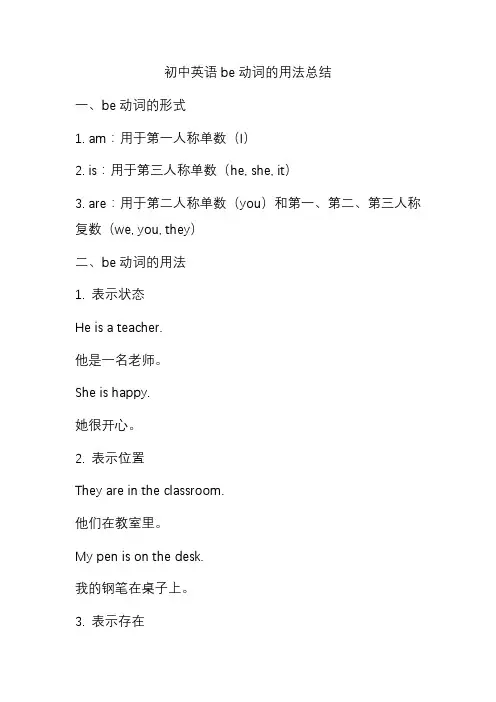
初中英语be动词的用法总结一、be动词的形式1. am:用于第一人称单数(I)2. is:用于第三人称单数(he, she, it)3. are:用于第二人称单数(you)和第一、第二、第三人称复数(we, you, they)二、be动词的用法1. 表示状态He is a teacher.他是一名老师。
She is happy.她很开心。
2. 表示位置They are in the classroom.他们在教室里。
My pen is on the desk.我的钢笔在桌子上。
3. 表示存在There is a book on the table.桌子上有一本书。
There are many students in the school.学校里有很多学生。
4. 作为助动词,构成进行时态和被动语态She is reading a book.她在看书。
The window was broken by Tom.窗户被汤姆打破了。
5. 连接主语和表语,构成系表结构You are beautiful.你很漂亮。
The weather is sunny.天气晴朗。
三、be动词的否定句和疑问句1. 否定句:在be动词后面加notHe is not a teacher.他不是一名老师。
They are not in the classroom.他们不在教室里。
2. 疑问句:将be动词提前Is she happy?她开心吗?Are you a student?你是学生吗?四、be动词的固定搭配1. be good at:擅长She is good at singing.她擅长唱歌。
2. be interested in:对某事感兴趣He is interested in playing football.他对踢足球感兴趣。
3. be famous for:因某事而著名The city is famous for its history.这座城市因其历史而著名。
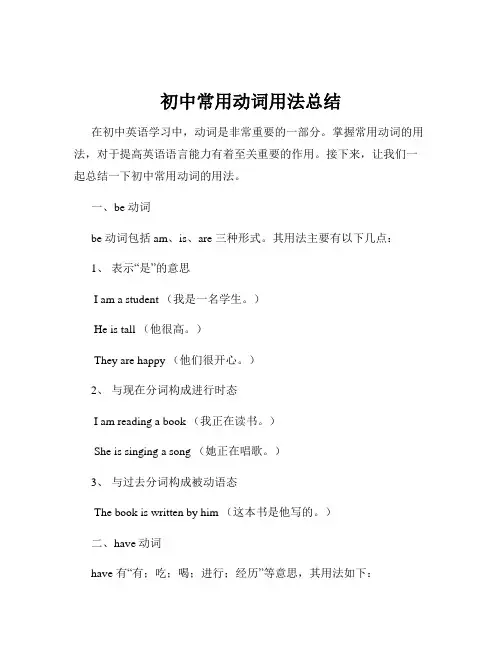
初中常用动词用法总结在初中英语学习中,动词是非常重要的一部分。
掌握常用动词的用法,对于提高英语语言能力有着至关重要的作用。
接下来,让我们一起总结一下初中常用动词的用法。
一、be 动词be 动词包括 am、is、are 三种形式。
其用法主要有以下几点:1、表示“是”的意思I am a student (我是一名学生。
)He is tall (他很高。
)They are happy (他们很开心。
)2、与现在分词构成进行时态I am reading a book (我正在读书。
)She is singing a song (她正在唱歌。
)3、与过去分词构成被动语态The book is written by him (这本书是他写的。
)二、have 动词have 有“有;吃;喝;进行;经历”等意思,其用法如下:1、表示“有”I have a pen (我有一支笔。
)They have many friends (他们有很多朋友。
)2、表示“吃;喝”Have some bread (吃点面包。
)Have a cup of tea (喝杯茶。
)3、与过去分词构成完成时态I have finished my homework (我已经完成了作业。
)三、do 动词do 用作实义动词时,表示“做;干”,用作助动词时,用于构成疑问句和否定句。
1、实义动词Do your homework (做你的作业。
)She does the dishes (她洗碗。
)2、助动词Do you like English? (你喜欢英语吗?)I don't know (我不知道。
)四、make 动词make 常见的意思有“制作;使;让”。
1、表示“制作”Make a cake (做一个蛋糕。
)2、表示“使;让”Make me happy (让我开心。
)五、take 动词take 有“拿;取;带走;花费”等意思。
1、表示“拿;取”Take this book (拿这本书。

初中语文动词重点归纳总结动词是语言中最基本的词类之一,它用来表示人、事、物的动作、状态、变化等。
在初中语文学习中,掌握动词的用法和意义对于提高语言表达能力和写作水平至关重要。
本文将对初中语文中的动词进行重点归纳总结。
一、动词的分类根据动词的词性和用途,可以将动词分为以下几类:1. 实义动词:表示具体的动作或状态,如跑、睡、梦想等。
2. 系动词:表示主语的状态或特点,如是、变得、看起来等。
3. 助动词:用来构成各种时态和语态,如会、要、能等。
4. 情态动词:表示说话人的情感、意愿、态度等,如能、应当、愿意等。
5. 不及物动词:表示动作只作用于主语自身,不需要宾语,如笑、走、睡等。
6. 及物动词:表示动作作用于宾语,必须有宾语才能完整表达,如读、写、做等。
二、动词的时态动词的时态主要分为以下几种:1. 现在时:表示现在正在进行或经常性发生的动作,如跑、吃、学习等。
2. 过去时:表示过去某个时间发生的动作或存在的状态,如跑过、吃过、学习过等。
3. 将来时:表示将来某个时间发生的动作,如将去、会见、要来等。
4. 现在进行时:表示现在正在进行的动作,如正在跑、正在吃、正在学习等。
5. 过去进行时:表示过去某个时间正在进行的动作,如正在跑步、正在吃饭等。
6. 现在完成时:表示过去发生的某个动作对现在造成的影响或结果,如已经吃完、已经学习过等。
三、动词的语态动词的语态有主动语态和被动语态两种,分别表示动作的主体是主语还是宾语。
1. 主动语态:表示主语是动作的执行者,如小明写信。
2. 被动语态:表示主语是动作的承受者,如信被小明写了。
四、动词的语气动词的语气主要分为陈述语气、祈使语气和虚拟语气。
1. 陈述语气:用于陈述事实、客观存在的情况,如他跑步锻炼身体。
2. 祈使语气:用于表达命令、请求、建议等,如请你帮我一个忙。
3. 虚拟语气:表示非真实或假设的动作、状态、愿望等,如要是我有时间,我就去看电影了。
五、动词的词形变化动词的词形变化包括人称和数的变化,根据主语的不同,动词会有不同的变化形式。
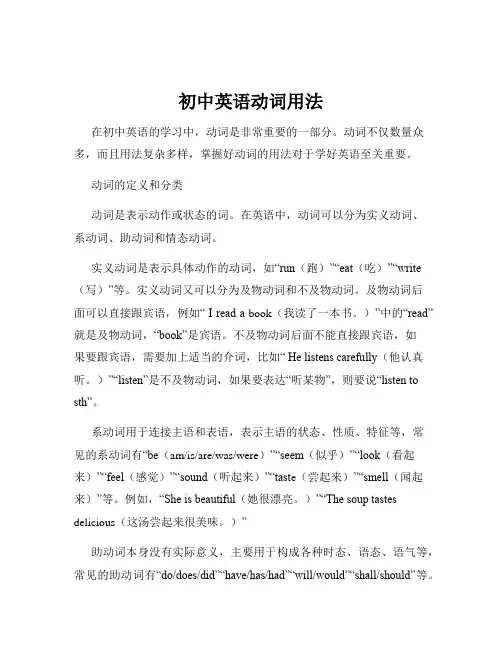
初中英语动词用法在初中英语的学习中,动词是非常重要的一部分。
动词不仅数量众多,而且用法复杂多样,掌握好动词的用法对于学好英语至关重要。
动词的定义和分类动词是表示动作或状态的词。
在英语中,动词可以分为实义动词、系动词、助动词和情态动词。
实义动词是表示具体动作的动词,如“run(跑)”“eat(吃)”“write (写)”等。
实义动词又可以分为及物动词和不及物动词。
及物动词后面可以直接跟宾语,例如“ I read a book(我读了一本书。
)”中的“read”就是及物动词,“book”是宾语。
不及物动词后面不能直接跟宾语,如果要跟宾语,需要加上适当的介词,比如“ He listens carefully(他认真听。
)”“listen”是不及物动词,如果要表达“听某物”,则要说“listen to sth”。
系动词用于连接主语和表语,表示主语的状态、性质、特征等,常见的系动词有“be(am/is/are/was/were)”“seem(似乎)”“look(看起来)”“feel(感觉)”“sound(听起来)”“tast e(尝起来)”“smell(闻起来)”等。
例如,“She is beautiful(她很漂亮。
)”“The soup tastes delicious(这汤尝起来很美味。
)”助动词本身没有实际意义,主要用于构成各种时态、语态、语气等,常见的助动词有“do/does/did”“have/has/had”“will/would”“shall/should”等。
比如,“He doesn't like sports(他不喜欢运动。
)”“They have finished their homework(他们已经完成了作业。
)”情态动词表示说话人的语气、态度或推测等,常见的情态动词有“can/could”“may/might”“must”“need”“shall/should”“will/would”等。
初中英语“使役动词”及其用法汇总1. make:- make + 宾语 + 动词原形:使人做事- make + 宾语 + 形容词:使人感到其中一种情绪或状态- make + 宾语 + 名词:使人成为其中一种身份或角色例句:- My mother made me clean my room.(妈妈让我打扫房间)- The movie made me cry.(这部电影让我哭了)- The teacher made him the monitor.(老师让他当班长)2. let:- let + 宾语 + 动词原形:让人做事- let + 宾语 + 名词:让人成为其中一种身份或角色例句:- My parents let me go to the party.(我父母让我去参加晚会)- The coach let him join the team.(教练让他加入球队)3. have:- have + 宾语 + 动词过去分词:让人做事- have + 宾语 + 形容词:使人拥有其中一种特征或性质例句:- They had me finish the report by tomorrow.(他们让我明天之前完成报告)- His success had the whole family proud.(他的成功使全家都感到骄傲)4. get:- get + 宾语 + 动词原形:让人做事- get + 宾语 + 形容词:使人处于其中一种状态例句:- I got him to help me with my homework.(我让他帮我做作业)- The cold weather got me sick.(寒冷的天气让我生病了)5. help:- help + 宾语 + 动词原形:帮助人做事例句:。
初中动词的用法
动词是语言中的一个重要部分,它用来描述动作、状态或者事件。
初中阶段,学生需要掌握一些常用的动词及其用法。
以下是初
中动词的一些基本用法:
1. 动作动词
动作动词用于描述人或物体所进行的动作。
例如:
- 我吃饭。
(I eat.)
- 他跑步。
(He runs.)
动作动词通常可以进行时态的变化,如过去式、现在进行时等。
2. 状态动词
状态动词用于描述人或物体的状态或特征。
例如:
- 我很高。
(I am tall.)
- 这个房间很脏。
(This room is dirty.)
状态动词通常可以进行否定形式的表达,如“不是/不在”的组合。
3. 情态动词
情态动词用于表示某种情态或意愿。
例如:
- 我可以帮助你。
(I can help you.)
- 你应该努力研究。
(You should study hard.)
情态动词通常可以帮助构成疑问句、否定句或者强调句。
4. 不规则动词
不规则动词是指在变化时不遵循常规形式的动词。
例如:
- 我们去了北京。
(We went to Beijing.)
- 我们吃了晚饭。
(We had dinner.)
不规则动词在时态变化时需要记住其特殊形式。
初中动词的用法是研究语法的基础,通过掌握动词的用法,学生可以更好地表达自己的意思。
> 注意:以上是初中动词用法的一个简要介绍,具体的内容和例句可以根据教材进行进一步研究和实践。
初中动词用法归纳1. 动词分为及物动词和不及物动词。
- 及物动词需要搭配宾语才能完整表达意思,比如:接电话、打篮球。
- 不及物动词不需要宾语,能够独立表达意思,比如:睡觉、走路。
2. 动词的时态可以分为一般现在时、一般过去时和一般将来时。
- 一般现在时表示经常性或惯性的动作,比如:我每天早上都刷牙。
- 一般过去时表示过去发生的动作,比如:昨天我去了图书馆。
- 一般将来时表示将来要发生的动作,比如:明天我将去购物。
3. 动词的语态可以分为被动语态和主动语态。
- 被动语态表示动作的承受者,比如:这本书被他借走了。
- 主动语态表示动作的执行者,比如:我写了一封信。
4. 动词的用法也可以根据动作发生的时间进行归纳。
- 现在进行时表示目前正在进行的动作,比如:我正在看电视。
- 过去进行时表示过去某个时间段内正在进行的动作,比如:他昨天这个时候正在吃饭。
- 将来进行时表示将来某个时间段内要进行的动作,比如:明天下午我将会在家研究。
5. 动词还可以根据不同的用法进行分类。
- 不规则动词有特殊的变化形式,比如:be动词的过去式是was/were。
- 情态动词表示可能性、能力等,比如:can、may。
- 动词短语是由一个主要动词和一个或多个帮助动词构成,比如:would like to、have to。
总结:初中动词的用法归纳主要包括及物动词和不及物动词、时态、语态、动作发生的时间和不同的用法。
理解这些用法有助于正确运用动词,更准确地表达自己的意思。
注意:以上内容仅供参考,请根据实际情况编写文档。
初中英语使役动词及其用法全汇总使役动词用于表示让人做事或使物发生其中一种变化。
以下是几个常见的初中英语使役动词及其用法:1. Let用法:Let后接名词或代词宾语,表示"让人做事",常用结构为"let + 宾语 + 动词原形"。
例句:Let me help you with your homework.(让我帮你做作业。
)2. Make用法:Make后接名词或代词宾语,表示"强迫人做事",常用结构为"make + 宾语 + 动词原形"。
例句:My parents make me study every night.(我父母强迫我每晚都学习。
)3. Have用法:Have后接名词或代词宾语,表示"让人做事",常用结构为"have + 宾语 + 动词原形"。
例句:I had my brother clean my room.(我让我弟弟打扫了我的房间。
)4. Get用法:Get后接名词或代词宾语,表示"让人做事",常用结构为"get + 宾语 + 动词原形"。
例句:He got his sister to buy him a new toy.(他让他的妹妹给他买了一个新玩具。
)5. Help用法:Help后接名词或代词宾语,表示"帮助人做事",常用结构为"help + 宾语 + 动词原形"。
例句:Can you help me carry these books?(你能帮我拿这些书吗?)需要注意的是,使役动词后的动词一般使用原形。
同时,不同的使役动词在用法上可能有一些区别,需要根据具体语境和需要选择合适的使役动词使用。
初中英语动词用法act v. 表演,演戏act as sb./ sth. 充任某角色,担任某工作I don’t understand English, so you have to act as my interpreter(翻译)。
其他用法:act for 代表某人,代理某人的职位During her illness, her lawyer has been acting for her in her business.在她生病期间,她的律师一直代理她的业务。
add v. (1)加,增加,添加add sth. to sth. 往...里添加...eg. If the tea is too strong, add some water to it.eg. He added his signature to the petition(请愿书)。
add A and B (together) 加eg. If you add 5 and 5, you get 10.add to sth. 增加某事物eg. The bad weather only add to our difficulties.这种坏天气更增加了我们的困难。
(2) 补充;继续说eg. “I’ll come here later.’’ he added.add in 包括...在内eg. Don’t forget add me in. 别忘了把我算上。
add up 合计,加起来add up to 总计达到add fuel to the fire 火上浇油afford v. 负担得起(...的费用,损失,后果),买得起;抽得出时间(常与can, could, be able to 连用)Afford sth. eg. I’d love to go on holiday but I can’t afford the time.eg. They walked because the can’t afford a taxi.afford to do sth. eg. They walked because they can’t afford to take a taxi.eg. I have to work hard because I can’t afford to loose my job. agree v. 同意,赞同agree with sb. 同意某人的意见eg. I agree with you. agree on + 表示具体协议的文件、计划、行动的词eg. We agreed on the plan. agree to do sth. 同意做某事eg. We agreed to start early. agree that + 宾语从句eg. She agreed that I was right.其他用法:agree with sb. (尤用于否定或疑问句) (对某人的健康或胃口)适合I like mushrooms but unfortunately they don’t agree with me.我喜欢吃蘑菇,可惜吃了以后难受。
The humid climate in the south didn’t agree with him.他不适应南方潮湿的气候。
aim v. 瞄准,对准aim at 瞄准,针对aim at the target 瞄准目标/ 靶子;aim at a success 志在成功eg. My remarks were not aim at you. 我的话不是针对你。
allow v. 允许,准许allow doing sth. eg. We don’t allow smoking in our house.在我们家不允许抽烟。
allow sb. to do sth. eg. They allow her to go to the party.他们允许她去参加晚会。
allow sb. in/ out/ up 允许某人进来/ 出去/ 起来annoy v. 使恼怒,使生气annoy sb. 使某人生气,使某人心烦eg. I was annoyed by his remarks. 他的言论激怒了我。
appear v. 出现;露面;(公开)演出appear to do 好象是It appears that + 从句eg. It appears to me that you are all wrong. 我觉得你们全都错了。
appreciate v. 感激appreciate sth. appreciate doing sth.argue v. 争论,争吵argue with sb. about/ over/ on sth. 与某人争论某事eg. We argued with the waiter about the price of the meal.其他用法:argue sb. into/ out of doing sth. 说服某人做/ 不做某事eg. They argue his into giving up his plan.arrive v. 到达arrive in + 大地方eg. We arrived in Paris.arrive at + 小地方eg. We arrived at the station/ my nation town.其他用法:arrive at sth. 达成或得出某事物arrived at an agreement(达成协议)/ a conclusion(得出结论)What dicision did you arrived at? 你们做出了什么决定?ask v. 询问,问ask sth. eg. May I ask questions?ask sb. sth. eg. He asked me the way to the supermarket.He asked me their names.He asked me where he should go.ask sb. about sth. eg. He asked me about my health.ask sb.to do sth. eg. He ask me to stop smoking.He ask me not to swim here.ask for sth. (to do sth.) 请求eg. She asked for more time (to think it over). 她请求多一点时间(仔细考虑)。
ask for sb. 找(某人)Did anyone ask for me last week?其他用法:ask the way 问路;ask for trouble 自找麻烦,自讨苦吃attempt v. 企图,试图试图做某事attempt to do sth.attempt doing sth.beat v. 打败,战胜beat sb. (at sth.) 在某方面打败/ 胜过某人He beats me at chess. 他在下棋方面胜我一筹。
beat sb. 打某人become v. 成为,变成become + 名词He became a doctor at last.become interesting in 变得对...感兴趣其他用法:What becomes/ will become of sb./ sth.? 某人某事的情况如何eg. What will become if I die? 假如我死了我的孩子会怎么样呢?12clean v. 打扫,清除clean sth. up 把...收拾干净check in 登记combine v. 结合,组合combine with 和...组合come v. 来;来到come after sb. 追赶或追逐某人come back 回来come from = be from 从...哪里来,来自...come by 从...旁边走过come down (雨、雪等)落下;(价格)下降eg. The price of petrol is coming down.汽油价格正在下跌。
come on 加油come for 为...而来eg. I am coming for my books which were lent to you last year.我为了去年借你的那些书而来。
(我想要回去年借给你的书)come out 出来;发芽come through 经历(困难等)come to an end 结束come up with sb. 赶上,追上communicate v. 交流,沟通communicate with sb. 与某人交流compare v. 比较compare A and B = compare A with/ to B 加以比较,两者相比较eg. If you compare her work with his, you will find hers is much better.compare A to B 把A比作Beg. Poets have compared sleep to death. 诗人把睡眠比作死亡。
compare notes (with sb.) 交换意见、观点、看法等complain v. 抱怨complain to sb. about / at sth. 投诉,抱怨,发牢骚eg. She often complain to me about her partner.concentrate v. 集中,聚集concentrate on/ upon 集中精力consider v. 考虑,思考,认为consider sth. 考虑...consider doing sth. 考虑... eg. I am considering changing my job.我正考虑换个工作。
consider sb./ sth. as 把...当...来对待eg. We consider him as our friend.consider sb./ sth. to be 把...当作...eg. We consider him to be our best friend.continue v. 使继续,坚持下去continue to do sth. = continue doing sth, 继续做某事To be continued. 未完,待续。
copy v. 复制,抄袭copy sth. from sb. 抄袭某人的...copy sth. down/ out in/ into sth. 把....抄写在...上eg. The students copied the sums (算术题) down in theirn notebooks.学生把算术题抄在他们的笔记本上。